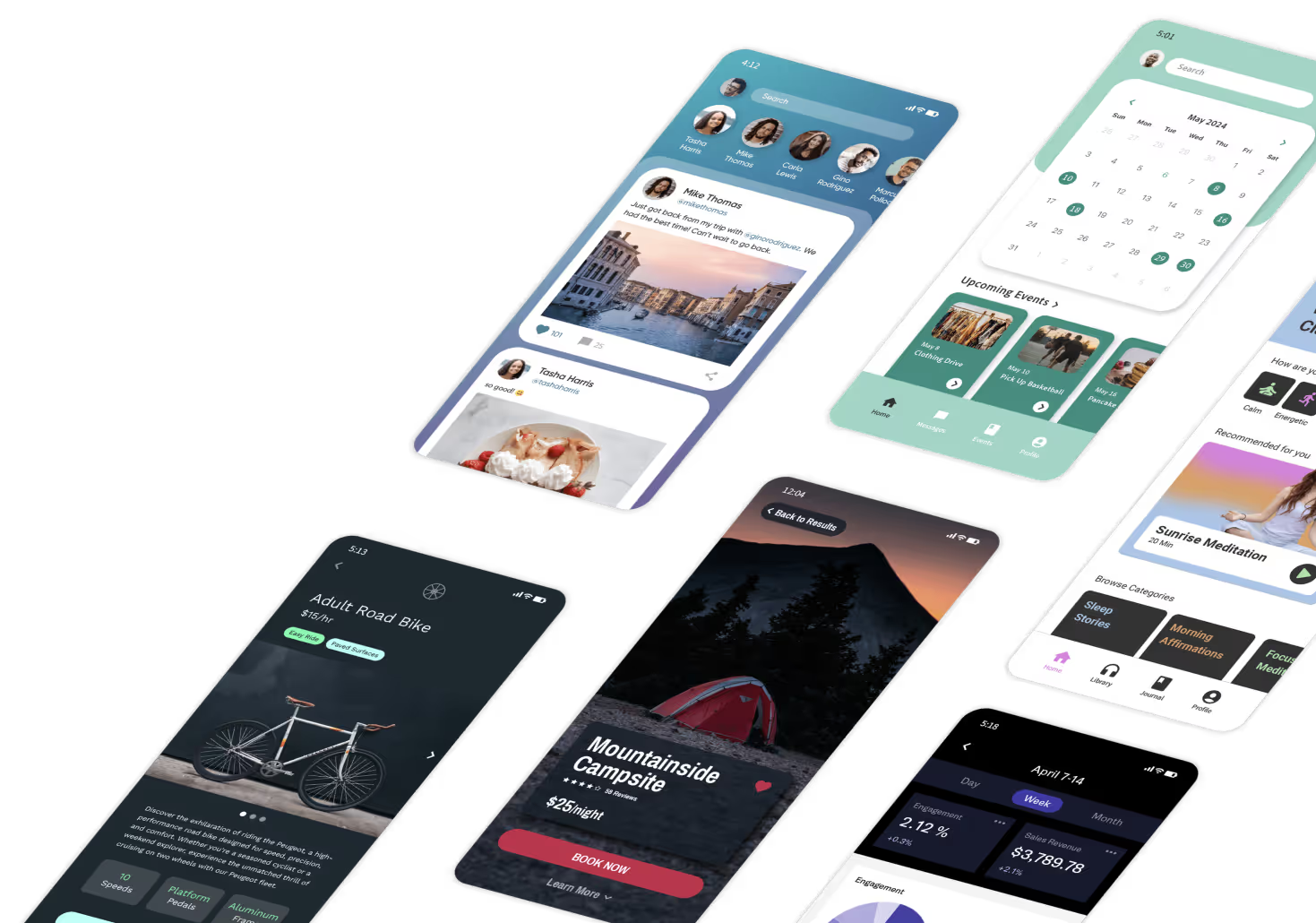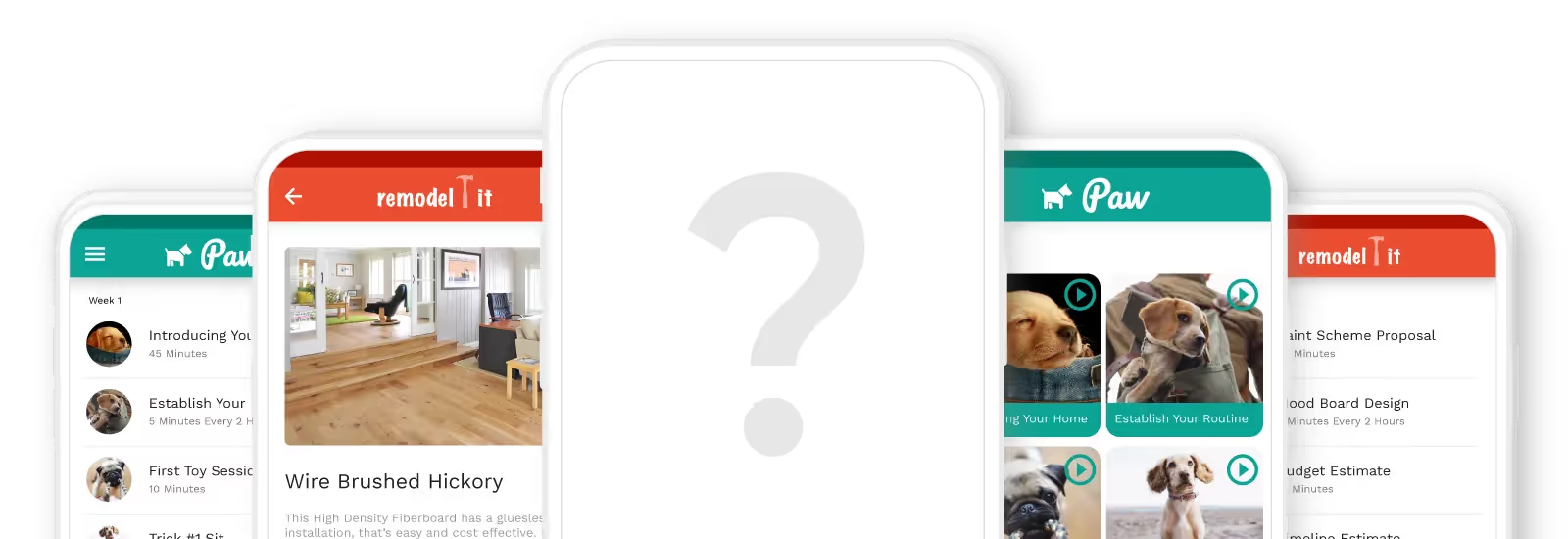
Ready to bring your app idea to life without writing code? Explore the 6 best WYSIWYG app builders for 2025 including the top choices of Adalo, Bubble, and Glide.
Whether you’re looking to publish to the app stores, get loads of customization options, or work with sparklingly beautiful templates, there’s an option for you here.
Read on to learn more about:
- What WYSIWYG app builders are, and the kinds of apps you can build with them
- What we look for in the best WYSIWYG app builders
- Our 6 favorite WYSIWYG app builders, and a glanceable table for quick comparison of features
- Some FAQs and answers
- Why Adalo is the best for WYSIWYG app development
Let’s now answer the burning question: What is a WYSIWYG app builder?
What is a WYSIWYG App Builder?

Just a little introduction to my background: I’ve been trying and reviewing WYSIWYG app builders for over a decade. My reviews have been read by over 1,000,000 (seriously, I track this!) people just like you since 2014. I’ve spoken to and advised hundreds of people from all walks of life about every app-building platform on the market. And every one of those people was looking to build apps in the easiest way possible, just like you.
If you’re looking for a “WYSIWYG” app builder, then you probably already know that it stands for “What You See Is What You Get.”
In practice, WYSIWYG means you want an app builder with a drag-and-drop interface for creating your app, an abundance of templates, and other pre-created features.
All of these features allow you to create your very own app without using code. And above all else, a WYSIWYG app builder should have an easy-to-use interface.
WYSIWYG App Builders vs. Traditional Development
One of the first questions I get is this: “Do I need coding experience to create an app with a WYSIWYG application builder?” The answer is a resounding no.
WYSIWYG app development is much different than traditional coding. Ultimately, anyone can create their own app using a WYSIWYG app builder — you won’t need to use any programming language or know any technical concepts.
Here’s how WYSIWYG app builders work: They leverage a drag-and-drop interface, which operates much like simple design software. You’ll be able to customize your app’s layout, colors, and structure using only your mouse and simple keyboard commands — no JavaScript, Python, or other coding languages needed.
What Kind of Apps Can You Build With A WYSIWYG App Builder?
- Native mobile apps: When people say “app,” this is usually what they mean. These are “proper” apps that you download directly to your phone from the Apple App Store or Google Play.
Because they’re published in those app stores, your customers, team members, family, and friends can easily find them.
- Progressive web apps: Often shortened to “PWAs,” these look, work, and feel like native mobile apps. Users download them directly to their phones from a link because they can’t be published in the app stores.
They also don’t always have great support for “native” functionality like GPS and push notifications.
- Web apps: These are websites where you can log in and access private information, like Facebook, Zillow, or your bank account. These can only be accessed on a web browser like Chrome and are not a traditional native app, but if they’ve been built with “responsive design” (fancy talk for optimized view for mobile and desktop) then they’ll look good on both your laptop and mobile phone web browsers.
What We Look For in the Best WYSIWYG App Builders
After years of testing and recommending app builders, I’ve discovered that these features are the most important to consider:
- Flexibility and customization: If you’re building an app, you’re doing so to have it execute specific tasks and complete jobs. I’ve picked out app builders that give you the freedom to create what you want, with maximum customizability, the ability to connect to other apps and services, and plenty of power under the hood.
- Ease of use: WYSIWYG means simple, so I’ve picked out the easiest app builders available in 2024. Each of these tools is beginner-friendly, and I can attest because I’ve personally seen non-technical people use them to create slick apps.
- Beautiful, useful templates: No matter how user-friendly and flexible an app builder is, you’ll want to start building as soon as possible. I’ve looked at each tool’s template marketplaces to ensure you can get the best functionality and an attractive interface for your app right out of the box — without having to be a professional designer!
- Support and tutorials: Each tool on this list makes app-building simple, but chances are you might get stuck. So, each app builder on my list not only has great support but also tools that come with tutorials and helpful videos to help you build and polish any app idea.
- Actually no-code: Lots of “WYSIWYG” builders claim to be “no-code” but then require you to understand technical concepts or how code stacks work. Not cool. My list only has true no-code tools, which can build everything you like without any pre-existing tech knowledge.
The Best WYSIWYG App Builders
- Adalo for native mobile apps you can publish to the app store
- Bubble for web apps with extreme customization
- Glide for beautiful, easy apps
- Softr for web apps without a learning curve
- Noloco for powerful business tools
- Good Barber for simple e-commerce apps
#1 Adalo

What is it?
Adalo is a drag-and-drop WYSIWYG app builder for building mobile (and web) apps that can be published to the app store.
What I like about it
While it lets you publish your apps to the Apple App Store and Google Play Store, it has a free version that allows you to publish your app to the web — many WSYWYG app builders don’t come with a free publishing feature.
On top of that, it’s the easiest to use on my list, infinitely customizable with plenty of third-party extras, like plugins made by the Adalo developer community.
Who is it best for?
Adalo shines for non-techies who have any app ideas. It’s the app builder that I’ve recommended more than any other for freelancers, entrepreneurs, and small and medium businesses.
What’s the support like?
Adalo is always ready to respond to app issues you run into. They also provide a Slack community and Forum for instant help.
Pricing
Adalo is one of the more affordable options on my list, with pricing starting at $45/month and most users being comfortable at the $65/month price point. Unlike alternatives, Adalo has an unlimited-time free plan.
Features
- Ready to go templates: Adalo doesn’t just provide templates that have complete screens, it gives you a full-on prebuilt database. You can jump in and customize every pixel of every screen to your exact taste, and tailor the premade database to your needs.
- Responsive apps: The mobile app you build on Adalo doubles as a website. For instance, this means you can have a mobile booking app, and with one click and zero extra work, it becomes a website booking system that your clients can access via their browser.
- Loads of third-party integrations: Need to connect your Airtable database or your QuickBooks account to your app? Adalo lets you do so, in fact, Adalo comes with over 5,500 integrations that you can take data from to supercharge your app.
- Magic Start, Adalo’s AI: Adalo is not sitting by the wayside during the AI revolution. Just command Magic Start, Adalo’s AI-powered feature, exactly what you want to build. It’ll generate the data you need and let you get straight to building screens.
Get started for free with Adalo.
#2 Bubble

What is it?
Bubble is a super-powerful web app builder that comes with a bit of a learning curve.
What I like about it
With Bubble, there’s really no limit on what you can build. It also has the biggest collection of third-party plugins and features, allowing you to configure and customize your web app to complete any task you wish.
Who is it best for?
If you love tech and want to put in some serious hours learning Bubble’s complex learning interface, you’ll be rewarded with unparalleled app-building possibilities. Because Bubble can’t build native mobile apps to publish in the app stores, it’s a good choice for those who want a web app only.
What’s the support like?
Bubble’s tech support team is always available by email, and their forum is the most active in the no-code app-building space. So if you’ve got a question, you can seek answers in several places.
Pricing
Bubble’s pricing is complicated — there’s an unlimited free plan, and it only costs $32/month (billed monthly) to launch your app. But you’ll be charged much more if you exceed your monthly “Workload Units'' quota.
Features
- Responsive design: You’ll want your web apps to look good whether your user is on a desktop, laptop, or iPhone. Bubble has a built-in responsive design system, so your app will look good no matter which devices your users view it with.
- Version control: Bubble lets you create several different versions of your app, with different branding or features. You can release one version, then release another version after pulling the first version. This helps you find which version your users like the most.
- Bubble Academy: Want to become a Master Bubble Builder? Check out their full library of videos and lessons covering everything from getting started to advanced building techniques.
- Ecosystem: Because they’ve been around since 2012, Bubble has the biggest ecosystem in the no-code space. You’ll find hundreds of templates, tutorials, hireable experts, and plugins. So if you've got a problem, want to find a unique plug-in, or there’s a particular part of the building interface you want to learn, it’s likely that you’ll find it on Bubble.
#3 Glide

What is it?
Glide is a point-and-click mobile and web app builder for businesses and organizations of all sizes.
What I like about it
Glide provides the best design on the list, meaning that the app you create with Glide will be nothing short of stunning. They’ve also got cutting-edge AI features, which can execute tasks like describing pictures, organizing data, and summarizing documents.
Who is it best for?
If you want to make an absolutely gorgeous app and don’t need tons of customization options, Glide is the best choice for you.
What Is the support like?
Instead of email support, Glide has live chat support to help. And you can also consult some of their helpful video tutorials on YouTube.
Pricing
Glide is priced on the higher end, with its version for individuals costing $86/month (billed monthly), allowing you to make up to 3 apps. If you’re building an app for your company, you’ll need to pay $249/month (billed monthly), but you’ll get to have 20 internal users and up to 5 app-editors.
Features
- Database integrations: If you’ve got your own database, you’ll be happy to know Glide has integrations with popular data sources like Airtable, Google Sheets, and SQL. Plus, Glides' data editing interface is very easy to use.
- Templates: Glide has a thriving template marketplace with both free and paid options starting from under $20 per template to in the $100s per template. As you’d expect, these all pass Glide’s (high) aesthetic standard, and they’re easy to use.
- Workflows: If you’re looking to create a project management tool, Glide’s a great option. It comes with a built-in workflow creator, allowing you to combine different actions, like sending emails, changing customer data, creating calendar events, or any other powerful features for your app.
#4 Softr

What is it?
Softr is a drag-and-drop web app builder that requires you to have a database to build.
What I like about it
Once you connect your database, Softr has an easy-to-understand “building blocks” interface for building out your app’s screens. Softr also lets you transform your web app into a PWA with one click, which can help you attract more users by posting the PWA-download link to your socials or sending it to clients.
Who is it best for?
If you want to quickly build a web app from your pre-existing database and don’t need advanced functionality and tons of features, Softr is the right choice.
What’s the support like?
Softr provides 17-hour-per-day (07:00 - 0:00 Berlin time) coverage with live chat, even on the free plan.
Pricing
Softr has a rigid pricing plans, starting at $59/month (billed monthly) and quickly jumping to $167/month (billed monthly). But its free plan is the second-most generous one next to Adalo, allowing up to 100 users.
Features
- Workflow Automations: Softr integrates with popular automation services like Zapier and Make, allowing you to send emails and SMS messages right from your Softr app. You’ll also be able to connect to over 5000+ apps and services.
- Payments: Softr comes with built-in support to take payments. While every option on this list can also do this, Softr’s integration is robust as it supports many platforms like Stripe, PayPal, and Gumroad as payment gateway options.
- Charts: If you want to organize data or create a dashboard view (like what you might see on your electricity provider’s website), Softr comes with plenty of options for creating and displaying visuals like Gantt Charts, Kanban Boards, and more.
- E-signature: If you plan on using your app to create contracts or gather signatures for something important, Softr’s got you covered. It comes with support for e-signatures.
#5 Noloco

What is it?
Noloco is a no-code web app builder that lets businesses create useful apps to execute internal processes.
What I like about it
If you’re like most businesses, you have a few databases. Noloco allows you to create super powerful, feature-rich apps from your databases, allowing you to gather more data to harness unique insights and execute day-to-day tasks.
Who is it best for?
Noloco is for businesses of all sizes that need a more powerful and advanced option than Softr.
What’s the support like?
Noloco has a live chat option to reply in around 20 minutes. You’ll also get access to the Noloco community, which has members who can walk you through any issues you encounter.
Pricing
Unfortunately, Noloco’s weak point is that it doesn’t offer a free version. But you can get started with Noloco for just $49/month (billed monthly). You’ll get several database integrations and 10 users. If you have a bigger team, check out the Pro Version at $149/month (billed monthly) giving you up to 50 users.
Features
- Unlimited apps: You’ll get to build as many apps as you need. You can create an app for your project management team, one for your sales team, and another for your accounting team. Then, streamline the features that you need into one master app.
- Integrations: Noloco is integrated with popular business software like Asana, Hubspot, Eventbrite, and more, so you can connect all the information from your current accounts to the apps you build with Noloco.
- 7 Database Connections: Out of all the WYSIWYG app builders, Noloco integrates with most databases, including Xano, Airtable, Smartsuite, Google Sheets, Postgres, and SQL.
- Automation buttons: Command your Noloco app to complete those time-consuming and mundane tasks by adding automation buttons. These can help you send clients reminder emails, automate cost data gathering from your accounting software, and more.
#6 GoodBarber

What is it?
GoodBarber is a no-code native mobile app builder that specializes in creating apps for e-commerce.
What I like about it
You’ll get access to dozens of pre-made templates that can help you sell nearly anything. And, you can use GoodBarber’s simple drag-and-drop interface to upload your own products and customize your app to meet your brand.
Who is it best for?
Whether you’re selling supplements, apparel, or written content, GoodBarber has the templates and tools to meet your needs.
What’s the support like?
GoodBarber offers 24/7 live chat support for all its pricing tiers.
Pricing
Although GoodBarber doesn’t have a free version, they do offer a 30-day free trial with no credit card required. If you’re a Content Creator and want to offer your periodical or ebooks on your GoodBarber app, go for the $36/month (billed monthly) version.
Features
- Different plans for different niches: GoodBarber separates its pricing tiers to ensure its plans are costed fairly. For instance, its Product Seller Plan provides the features that only sellers of physical products, not sellers of content, need, like access to delivery services.
- Publish your apps to the app stores: You can publish your GoodBarber-made app to the Apple App Store and Google Play Store, which gives you an opportunity to get your e-commerce app in front of billions of eyes.
- Also publishes as a web app: To maximize the number of customers, you’ll also be able to release your app to the web. This means that clients who aren’t using their phones can still shop in your store as if it were a website.
- SEO features: GoodBarber lets you optimize each product on your app for Google, which can help increase the chances that you’ll get new customers from Google searches.
FAQS
What’s The Best Tool if I’m On a Budget?
Although Bubble is the cheapest, at $32/month (billed monthly), you’re limited by “Workload Unit” costs, which can increase your monthly bill, and you’ll also have to tackle a tough learning curve.
Adalo has a generous free plan and you can build a legitimate app business on their $36/month plan (billed annually).
What’s The Best Tool if I Know a Little About Computers?
Because Bubble is a little tough, knowing your way around a computer will make learning it much easier, although it will still take a few months to nail down.
A better option is to take your computer skills and build an app with Adalo. You’ll be able to catch onto an already simple app builder much more quickly than most, which will help you leverage its near-infinite potential.
What’s the Best App Builder for Businesses with a Database?
You’ll need to have a database to start with Softr, but if you’re looking to make a business tool out of your database, check out Noloco. It integrates with 7 different databases, including Xano, Airtable, SQL, and Google Sheets.
If you want to build a client-facing app out of a database, Adalo is an excellent choice because it’s easier than both Softr and Noloco and provides more power with several customization options, plugins, and integrations. Plus, you’ll be able to connect your Xano, Airtable, or Google Sheets database.
Do I Really Need a Native App?
For overall optimal functionality, a native app will give you better access to phone-only features like GPS and camera because native apps can use all the processors inside your phone. You’ll be able to do much more with these features than you could in PWA-only platforms like Glide and Bubble.
Arguably, more importantly, building a native app gives you access to the Apple iOS App Store and the Google Play Store. These are enormous distribution platforms that can get your app in front of billions of users and make it easy for anyone to download your app — but you do need to pay. For example, Apple’s app store costs $99/year, and Google has a one-time fee of $25.
'{{rich-cta}}'
Next Steps: Build Your App with Adalo
Looking for a WYSIWYG app builder that provides nearly pixel-perfect design freedom and doesn’t take hours upon hours to learn? Go with Adalo.
Adalo is by far my favorite WYSIWYG app builder. It’s simple enough to learn right after signing up, and it even features its own WYSIWYG database application builder, so you won’t need to learn (or pay for) a third-party database builder.
You’ll also get enough design freedom to move elements, free-form, across each screen and place them precisely where you want. Change up the color, add your logo, and then publish it on the web, the Apple App Store, and Google Play Store so your app gets maximum exposure.
Try out Adalo for free and publish your first web app today.














